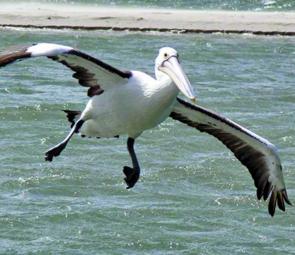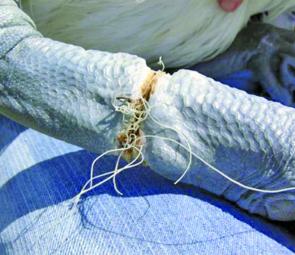Fish hooks can cause painful injuries and only an idiot would knowingly drop a hook on the ground and leave it there where someone might walk on it. But many fishers, including myself, have casually dropped unwanted lengths of fishing line without realising that it can be just as destructive as a hook, especially for wildlife. That’s because discarded line readily tangles around the feet of native birds, particularly foraging seabirds and the outcome can mean weeks or months of intense suffering for the luckless creature.
Some years ago I began rescuing birds that had become entangled in fishing line. Before that time I had no idea how badly it could affect them. I’ve caught and released hundreds of birds that have fallen victim to discarded line and feel compelled to tell you about the damage it can do and the simple solutions that eliminate the problem completely.
Light weight fishing line is a big threat to native wildlife because it tangles so easily. Braid is the worst because it has no stretch and readily cuts into flesh. Just half a meter of light line dropped unwittingly on the ground can spell disaster for a foraging bird. No species is immune to this menace – all birds from pee wees to pelicans readily succumb.
Most birds become entangled when they’re walking and foraging for food. The trouble begins when a length of discarded line accidently catches on a bird’s toes. The bird will try to kick it off. If it’s lucky it will free itself, if not the line will wrap around its feet. Fishing line doesn’t biodegrade or break down quickly. Soon the bands of line tighten and this causes swelling. As the limb swells the line cuts deeper into the bird’s flesh. So begins a long period of intense suffering that often leaves the bird maimed or dead.
Line tangles occur mostly in coastal areas where fishing is popular. Birds with blunt beaks suffer the most – pelicans, swans, ducks, oyster catchers, gulls and of course the poor old white ibis. Their beaks aren’t shaped in a way that allows them to bite the line and free themselves. Cormorants, kites and ospreys do a bit better because they have sharp hooked beaks that can sometimes nip the line off. However, biting is no use at all if a fish hook is also involved, which is often the case.
On average I catch two or three birds every week that have line or hook injuries. This usually follows a call from a member of the public who’s seen a bird limping badly. The caller can’t help the creature because most entangled birds can still fly. If they’re not caught and treated many will lose toes and some will lose a whole foot or even a wing. Others die from infection. It’s not uncommon for me to catch a bird that has three different weights of line caught around its feet. Some birds have line wrapped around both legs and are hobbled. Others have hooks deeply embedded in their flesh adding to their misery.
These terrible injuries are the direct result of people dropping unwanted lengths of fishing line on the ground without thought for who or what it might injure. I know that most fishers will be horrified to learn that this harmless looking material can cause such problems. The fact is we rarely hear about these problems. It’s especially distressing when the solution is so obvious and simple.
Catching an injured bird that can still fly requires special techniques. You can’t just throw a towel or a net over it. They’re way too smart for that. Most have to be snared. What I find really rewarding is that many of these rescues are catch and release. Once a bird is caught and made secure, the line can be cut free and wounds treated. If the injuries aren’t too bad the creature can go back into the air straight away, although it’s often without a toe or two. Seriously injured birds have to go to hospital. Some make it, many don’t. It’s awful to see a bird with a foot that’s just hanging on by a piece of skin having been slowly amputated by fishing line. If a dog loses a leg it has another three to help it balance and get around. When a bird loses a foot it’s lost its entire capacity to walk and can no longer forage successfully. Big birds like pelicans and swans don’t cope at all. They have far too much body weight to support themselves on just one leg.
So, how much discarded line is lying around on the ground in popular fishing areas? The amount varies from place to place. Fishing line is not biodegradable and can remain on the ground for years. I often walk along the break wall at the Gold Coast Seaway. This is a popular fishing spot. It’s not uncommon for me to pick up several lengths of discarded lightweight line totalling 50m in length every time I walk there. This is a real problem given that half meter is more than enough to entangle a bird. Sometimes I’ll find discarded lengths of light braid up to 10m long. That’s just wrong. Anyone who’s experienced a big hook up on light braid knows how dangerous that material can be if it gets caught around your fingers. All fishers go out with the expectation of catching fish not birds or animals, but unless unwanted gear is disposed of correctly that’s exactly what happens.
Fortunately the solution is simple. Never drop off cuts of fishing line. If you fish or know someone who does tell them how destructive discarded line can be. They probably have no idea at all. If people know about the damage it can do they’ll be much less likely to drop the stuff. Properly disposing of discarded line solves the problem immediately.
What about discarded line that’s already out there? This is where you can help. When you go fishing or whenever you’re walking at a popular fishing spot keep your eyes peeled for line that’s lying around on the ground. It only takes a few seconds to pick it up. Wind the line into a tight ball and tie it off before dropping it in a bin. Better still grab your knife and cut through the ball of line to reduce it to very short lengths before binning it, as many birds, including pelicans, actually get tangled at the rubbish tip.
Take care whenever you pick up scrap line because you never know what’s on the other end. I copped a rusty fish hook in my thumb the other day and had to check my tetanus status. Remember that every piece of discarded line you collect will prevent it from causing intense suffering to one of our native birds.
A bird will occasionally fly directly into a fisher’s line and get tangled or hooked. If this happens don’t just cut it free. If it’s a small bird pull it in and drop a towel over it. Take the normal precautions not to get bitten or scratched. In many cases the bird can be untangled and a superficial hook removed quickly. If the bird has swallowed a hook or has a more serious injury put in a cardboard box and take it to the nearest vet. Most vets will treat injured wildlife for free and some offer a 24 hour service.
If the bird is too big for you to handle and can’t be temporarily tethered then cut the line and report it straight away. All States have volunteer wildlife organisations that will send someone out to catch the bird. Even if it can’t be caught on the day most birds are territorial and will hang around or return to the same area making capture at a later date possible.
You can get quick help for native birds and animals by searching the net or the phone directory under injured wildlife. If you are out fishing and need a contact number phone home or call a friend and ask them to look one up. All volunteer wildlife rescue services are free and quick action can prevent much suffering. – Rowley Goonan
Reads: 5333
All fishers go out with the expectation of catching fish, not birds or animals.

Fine fishing line and trace wrapped tightly around this pelican’s leg would have cost the bird its limb.




